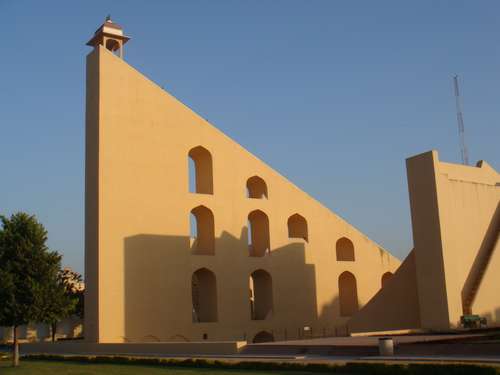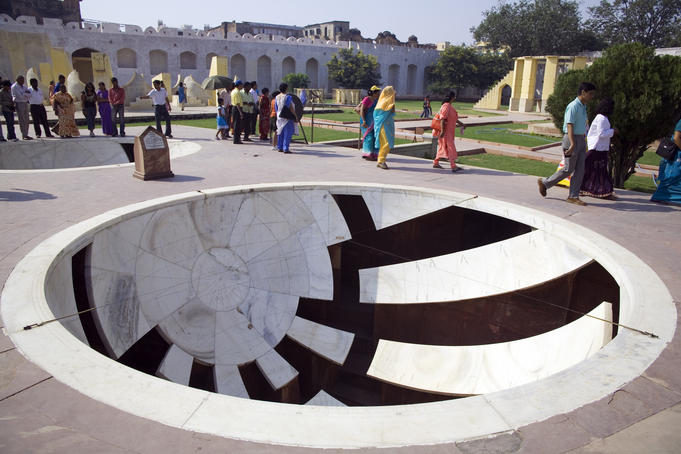Ever wondered why Jantar-Mantar is named so? Jantar means "instrument", and Mantar means "formula", or in this context- "calculation". Therefore Jantar-Mantar means 'calculation instruments'. These astronomical wonders are age old observatories and have scientific as well as religious significance, since ancient Indian astronomers were also Jyotisa masters. The instruments in Jantar Mantar are the pride of our nation and a must know for every engineer!
These were built by Maharaja Jai Singh II, also called Sawai Jai Singh of Jaipur, from 1724 onwards. He built these in 5 cities in India-
- Delhi
- Mathura (in his Agra province)
- Benares
- Ujjain (capital of his Malwa province)
- Jaipur
In all of these only the one at Jaipur is working. This is the largest and best preserved of these. It has been inscribed on the World Heritage List as "an expression of the astronomical skills and cosmological concepts of the court of a scholarly prince at the end of the Mughal period". Below is a summary of some interesting instruments there-
Ram Yantra
 Ram Yantra in Jantar Mantar is the device used for measuring the altitude of stars. It is a cylindrical instrument, consisting of two large buildings open to the sky. The beauty of the instrument is, that it gives us direct readings. Basically the instrument consists of two circular stone building. If we unite them together, it becomes one instrument. This way one is complimentary to the other. They are constructed at a reasonable distance. In the centre of the instrument a perpendicular rod is fixed, which is of the same height of the building itself. Twelve stone triangles are fixed above the ground. These triangular stone slabs are graduated from 90 degree to 45 degree, while 45 to 0 degree the graduations are on the circular wall. This is an instrument by which we come to know the movement of stars. It is based on the horizon and zenith system. For measuring the azimuth, readings are marked at equal distances along the circumference of the gnomon of Ram Yantra. For measuring the altitude, readings are marked on the flans and walls of the yantra.The readings on the walls can be understood using the elementary formula- tan ? = l/r
Ram Yantra in Jantar Mantar is the device used for measuring the altitude of stars. It is a cylindrical instrument, consisting of two large buildings open to the sky. The beauty of the instrument is, that it gives us direct readings. Basically the instrument consists of two circular stone building. If we unite them together, it becomes one instrument. This way one is complimentary to the other. They are constructed at a reasonable distance. In the centre of the instrument a perpendicular rod is fixed, which is of the same height of the building itself. Twelve stone triangles are fixed above the ground. These triangular stone slabs are graduated from 90 degree to 45 degree, while 45 to 0 degree the graduations are on the circular wall. This is an instrument by which we come to know the movement of stars. It is based on the horizon and zenith system. For measuring the azimuth, readings are marked at equal distances along the circumference of the gnomon of Ram Yantra. For measuring the altitude, readings are marked on the flans and walls of the yantra.The readings on the walls can be understood using the elementary formula- tan ? = l/r
Samrat Yantra
 The samrat yantra is a giant sundial which can be used to tell the time to an accuracy of about two seconds in Jaipur local time. It is the world's largest sundial, standing 27 meters tall. Its shadow moves visibly at 1 mm per second, or roughly a hand's breadth (6 cm) every minute. The gnomon is ninety feet high and has niches in to wall so that storms do not affect the instrument. The gnomon is right angled wall and the hypotenuse has steps to climb up. The hypotenuse has also a scale to find out the altitude of the sun. The hypotenuse points towards the pole. On either side of the pole is masonary quadrant. the centres of which lie on the edge of gnomon. The edge of quadrants are graduated in hours, minutes and seconds. In this scale one minute has been divided to the extent of 30 parts, this way it is accurate up to 2 seconds.
The samrat yantra is a giant sundial which can be used to tell the time to an accuracy of about two seconds in Jaipur local time. It is the world's largest sundial, standing 27 meters tall. Its shadow moves visibly at 1 mm per second, or roughly a hand's breadth (6 cm) every minute. The gnomon is ninety feet high and has niches in to wall so that storms do not affect the instrument. The gnomon is right angled wall and the hypotenuse has steps to climb up. The hypotenuse has also a scale to find out the altitude of the sun. The hypotenuse points towards the pole. On either side of the pole is masonary quadrant. the centres of which lie on the edge of gnomon. The edge of quadrants are graduated in hours, minutes and seconds. In this scale one minute has been divided to the extent of 30 parts, this way it is accurate up to 2 seconds.
Jai Prakash Yantra
 It is the most accurate, interesting, and educative among all the instruments of observatory. It will not be extravagant to say that this was an instrument which was built at last, so that he could verify the readings and calculations of other instruments. They were rectified with the help of it. The instrument is nothing but the cavity divided into two parts, each one complimentary to other. The cavity is nothing but the upside down of the earth. It has been divided into two parts, so that the measurer could go inside and calculate the readings accurately. The foundation has lead sheetings so that the various seasons donot affect the readings. Each of these two cavities are divided into six marble slabs, divided further into minutes and seconds. They are also bearing the inscriptions of twelve symbols of zodiac. In the middle of the instrument a ring is hanging with the help of the wires. It is an ideal instrument for demonstrating the the so called "doctrine of sphere" and showing to the eye, the apparent motions of the Sun, and would be great educational value to all commencing the study of astronomy. The marble slabs are alos introduced for the zodiac sysmbols.
It is the most accurate, interesting, and educative among all the instruments of observatory. It will not be extravagant to say that this was an instrument which was built at last, so that he could verify the readings and calculations of other instruments. They were rectified with the help of it. The instrument is nothing but the cavity divided into two parts, each one complimentary to other. The cavity is nothing but the upside down of the earth. It has been divided into two parts, so that the measurer could go inside and calculate the readings accurately. The foundation has lead sheetings so that the various seasons donot affect the readings. Each of these two cavities are divided into six marble slabs, divided further into minutes and seconds. They are also bearing the inscriptions of twelve symbols of zodiac. In the middle of the instrument a ring is hanging with the help of the wires. It is an ideal instrument for demonstrating the the so called "doctrine of sphere" and showing to the eye, the apparent motions of the Sun, and would be great educational value to all commencing the study of astronomy. The marble slabs are alos introduced for the zodiac sysmbols.
Dhruva Bhrama Yantra (Polar Rotation Instrument)
It is a rectangular board with a slit and a set of pointers with concentric graduated circles. Adjusting the slit, time and other calculations can be obtained with the help of pointers. Its back side was made as a quadrant with a plumb and an index arm. Thirty parallel lines were drawn inside the quadrant, and trigonometric calculations are done graphically. After determining the sun’s altitude with the help of the plumb, time was calculated graphically with the help of the index arm.
There are many such magnum opus instruments in these observatories. So next time you plan a trip, come to Jaipur. Jantar Mantar is by and large the greatest magic show you will enjoy!
